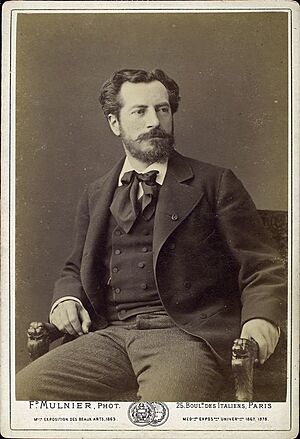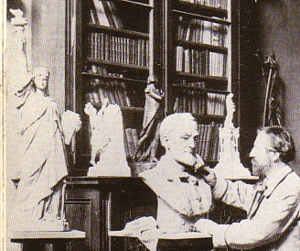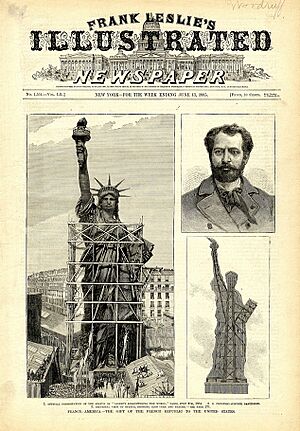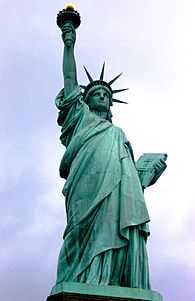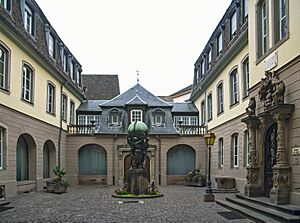Frédéric Auguste Bartholdi facts for kids
Quick facts for kids
Frédéric Auguste Bartholdi
|
|
|---|---|

Portrait by Nadar
|
|
| Born | 2 August 1834 |
| Died | 4 October 1904 (aged 70) |
| Resting place | Montparnasse Cemetery |
| Nationality | French |
| Education | Lycee Louis-le-Grand |
| Alma mater | École nationale supérieure des Beaux-Arts |
|
Notable work
|
Statue of Liberty |
| Spouse(s) |
Jeanne-Emile Baheux
(m. 1876) |
Frédéric Auguste Bartholdi (born August 2, 1834 – died October 4, 1904) was a famous French sculptor and painter. He is best known for designing Liberty Enlightening the World, which everyone calls the Statue of Liberty.
Contents
Early Life and Learning
Bartholdi was born in Colmar, France, on August 2, 1834. His family had roots in Alsace, a region in France. His father passed away when Bartholdi was only two years old.
After his father's death, Bartholdi moved to Paris with his mother and older brother. However, they often returned to their family home in Colmar. This house later became the Bartholdi Museum. While in Colmar, he took drawing lessons. In Paris, he learned about sculpture and architecture from famous teachers.
Bartholdi went to the Lycée Louis-le-Grand in Paris and finished his studies in 1852. He then studied architecture and painting at the École nationale supérieure des Beaux-Arts. Later, he decided to focus completely on sculpture, which became his life's work.
Becoming a Sculptor
First Big Projects
In 1853, Bartholdi showed his first sculpture at the Paris Salon, a famous art show. It was a group of statues based on the story of the Good Samaritan. Two years later, his hometown of Colmar asked him to create a bronze statue of Jean Rapp, a general from the time of Napoleon.
In 1855 and 1856, Bartholdi traveled to Yemen and Egypt. This trip made him very interested in creating huge sculptures. In 1869, he went back to Egypt to suggest building a giant lighthouse at the entrance of the Suez Canal. This lighthouse was meant to look like a huge figure holding a torch. However, the project was too expensive and was not built.
The Statue of Liberty Idea
Bartholdi served in the Franco-Prussian War in 1870, defending his home region of Colmar. After France's defeat, he created several monuments to celebrate French bravery. One of these was the Lion of Belfort, a massive sandstone statue he worked on from 1871 to 1880.
In 1871, Bartholdi visited the United States for the first time. He went there to propose a huge statue as a gift from France to America. This gift would celebrate 100 years of American independence. The idea for this statue came from his friend Édouard René de Laboulaye in 1865. This idea eventually led to the famous Statue of Liberty in New York Harbor.
It took many years to create the statue and raise money for it. Finally, the Statue of Liberty was officially opened in 1886. During this time, Bartholdi also made other monuments for American cities, like a cast-iron fountain in Washington, DC in 1878.
Later Years and Legacy
In 1875, Bartholdi joined the Freemasons, a social organization. He continued to create many statues, monuments, and portraits throughout his life. He showed his art at the Paris Salons until he passed away in 1904.
Bartholdi also worked with other art forms, including oil painting, watercolor, photography, and drawing. He received a high honor called the Commander of the Legion of Honor in 1886. Frédéric Auguste Bartholdi died from tuberculosis at the age of 70 in Paris on October 4, 1904.
Personal Life
In 1876, Bartholdi married Jeanne-Emile Baheux in Providence, Rhode Island. In 1893, he and his wife visited the World's Columbian Exposition in Chicago. There, his sculpture of Washington and Lafayette was on display. Bartholdi always kept his childhood home in Colmar. In 1922, this home became the Musée Bartholdi, a museum dedicated to his work.
Famous Artworks
The Statue of Liberty: A Gift of Friendship
Bartholdi's most famous work is Liberty Enlightening the World, known as the Statue of Liberty. After France became a republic again, people wanted to create a memorial to show the strong friendship between the United States and France. In 1874, the Franco-American Union was formed to support this project. Bartholdi's deep interest in freedom was influenced by his hometown of Alsace falling under German control during the Franco-Prussian War.
Bartholdi joined the Union, and once his design for the huge statue was approved, they raised over 1 million francs in France to build it. On July 4, 1880, the statue was officially given to the American minister in Paris. In October 1886, the Statue of Liberty was officially presented as a joint gift from the French and American people. It was placed on Bedloe's Island in New York Harbor. Some people in France believed the face of the Statue of Liberty was modeled after Bartholdi's mother. The statue is 46 meters (151 feet) tall. The top of the torch reaches 93 meters (305 feet) above the water. It was the largest statue of its kind ever built at that time.
Art in His Hometown: Colmar
Bartholdi's hometown of Colmar has many statues and monuments he created. There is also a museum, founded in 1922, in the house where he was born.
Some of his works in Colmar include:
- Monument du Général Rapp – 1856 (his first major work)
- "Fontaine Schongauer" – 1863 (in front of the Unterlinden Museum)
- "Fontaine de l'Amiral Bruat" – 1864
- "Fontaine Roeselmann" – 1888
- "Monument Hirn" – 1894
- "Fontaine Schwendi", showing Lazarus von Schwendi – 1898
- Les grands soutiens du monde − 1902 (a statue in the museum courtyard)
Other Amazing Sculptures
Bartholdi created many other important works in different cities. Some of his notable sculptures include:
- 1852: Francesca da Rimini
- 1870: Le Vigneron
- 1876: Frieze and four angelic trumpeters on the tower of Brattle Square Church, Boston, Massachusetts, United States.
- 1876: Marquis de Lafayette (or Lafayette Arriving in America), in Union Square, New York City, United States.
- 1878: The Bartholdi Fountain in Bartholdi Park, the United States Botanic Garden, Washington, D.C., United States.
- 1880: The Lion of Belfort, in Belfort, France. This huge sculpture of a lion shows the French struggle during the Franco-Prussian War.
- 1889: Switzerland Succoring Strasbourg at Basel, Switzerland. This was a gift from the French city of Strasbourg to thank Switzerland for its help during the Franco-Prussian War.
- 1890: Statue of Liberty in Potosí, Bolivia.
- 1892: Fontaine Bartholdi, in Lyon, France.
- 1893: Statue of Christopher Columbus, originally made for an exhibition in Chicago. A bronze copy was put up in Providence, Rhode Island in 1893 but was taken down in 2020.
- 1895: "Lafayette and Washington Monument," in Paris, and a copy in Morningside Park, New York City, United States.
- 1903: Vercingetorix, a statue of a man on horseback in Clermont-Ferrand.
Images for kids
-
Marquis de Lafayette, statue of Gilbert du Motier, Marquis de Lafayette in Union Square, Manhattan, New York City
-
Columbus statue, Providence, Rhode Island, erected 1892, removed 2020
-
Switzerland Succoring Strasbourg in Basel, Switzerland
See also
 In Spanish: Frédéric Auguste Bartholdi para niños
In Spanish: Frédéric Auguste Bartholdi para niños
- Musée Bartholdi
- Statue of Liberty Museum


